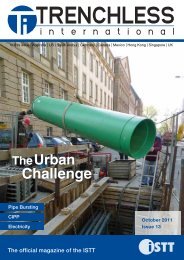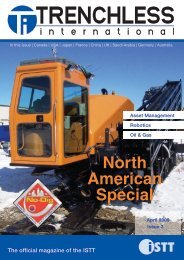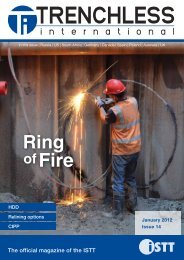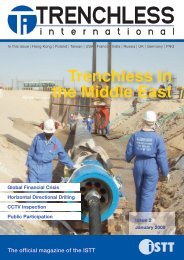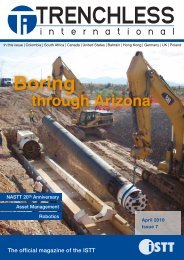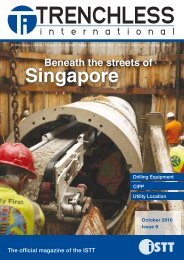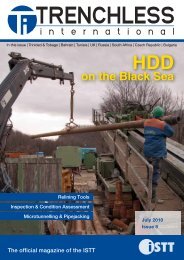tunnel's - Trenchless International
tunnel's - Trenchless International
tunnel's - Trenchless International
Create successful ePaper yourself
Turn your PDF publications into a flip-book with our unique Google optimized e-Paper software.
The myth, the fact, and<br />
the legend – sealing systems<br />
By LMKTechnologies Director of Marketing Kristina Kiest<br />
Infiltration found at a service connection may have more than one source; where one source<br />
is water that infiltrates through lateral pipe defects and another is water that tracks behind<br />
mainline linings and re-enters the collection system at service connections.<br />
In order to correct these deficiencies, a considerable amount<br />
of research and development has been initiated to produce a<br />
truly engineered mechanical end seal which is simple to install, is<br />
effectively secured to the inside of the pipe, and has a significant<br />
sealing surface and a low profile that maximises the cross section<br />
of the pipe opening.<br />
company news<br />
October 2012 - <strong>Trenchless</strong> <strong>International</strong><br />
Over the course of time, people have bought into stories that are believed to be true, only later to be found<br />
that the story is nothing more than a myth. A classic example of one such modern myth is the belief that<br />
cured-in-place pipe will not only restore the structural integrity of the pipe, but that it will also eliminate<br />
inflow and infiltration by bonding the liner to the host pipe preventing future leakage in a collection system.<br />
It is important to understand the purpose and the longterm<br />
goals for sealing a collection system. In any given collection<br />
system, inflow and infiltration (I&I) can cause havoc for valid reasons.<br />
However, there are circumstances where installing a new cured-inplace<br />
pipe alone is not enough to prevent I&I – this is particularly the<br />
case for greasy sewers and in sewers where hydrostatic loading is<br />
present. The standard industry practice for cleaning a sewer pipe in<br />
preparation for cured-in-place pipe (CIPP) lining often involves nothing<br />
more than hydraulic jetting to remove any debris in the pipe. The<br />
residual fats, oils, and grease (FOG) present on the walls of a host<br />
pipe are in no way diminished due to high pressure hydro cleaning.<br />
Sealed with a gasket<br />
These problems have not gone unnoticed, and over the years<br />
there have been numerous attempts to correct these issues without<br />
notable success. The attempted remedies range from methods of<br />
injecting a chemical grout post-lining, to packing of cementitious<br />
material at the liner/manhole interface, to the insertion of expanding<br />
end seals positioned in the pipe prior to lining.<br />
The concept of a compression gasket to form an engineered seal<br />
is an accepted industry practice used for years in the installation<br />
and joining of sewer pipes. Even though the engineering society<br />
understands that the best long-term solution is an engineered<br />
gasket seal, one must select the proper gasket, which is designed<br />
for CIPP applications.<br />
The use of a hydrophilic rope or belt shaped material commonly<br />
used in a cold-concrete-joint is not suitable for CIPP renewal works.<br />
Those who have attempted to use this type of seal will appreciate<br />
the challenges of effectively securing a penannular or non-monolithic<br />
gasket to the inside of a pipe. Some of the problems that occur with<br />
this method are that gluing anything into a wet and greasy sewer<br />
Effects of I&I on a collection system<br />
• Requires additional energy which equates to<br />
additional tax dollars spent<br />
• Overtaxing of the collection system whereby<br />
reducing capacity<br />
• Sewer overflows that pollute our environment<br />
and adversely affects clean water<br />
Inset Insignia T Liner.<br />
pipe is a challenge in itself. If the gasket falls over during insertion of<br />
the liner, the result is a large bump at the invert of the pipe; or the<br />
contractor simply doesn’t install the problematic gasket as required.<br />
Even if one were to assume the gasket could remain in-place as the<br />
liner is inserted, the ends of the gasket would have to abut or overlap.<br />
The belt type gasket creates a significant opportunity for separation<br />
or a gap in the gasket resulting in continued leakage where hydraulic<br />
loading is present. Furthermore, these belt shaped gaskets are<br />
fairly narrow, producing an insignificant sealing surface. They are<br />
also quite bulky in thickness, reducing the cross section of the pipe<br />
which may hinder the insertion of robotic cutters, maintenance and<br />
lateral connection lining equipment.<br />
A total system seal<br />
Those who invested in the research and development of LMK’s<br />
Insignia Hydrophilic Sealing System could not stop supporting<br />
the research project until it proved to conclude a total system seal<br />
that is compatible with all mainline CIPP systems – regardless if<br />
the mainline liner is pulled into place or inverted into place. To<br />
achieve the objective of a total sealed system, the team had to first<br />
identify additional locations for continued leakage post mainline<br />
CIPP rehabilitation. Identifying this source was quite simple, as<br />
the trenchless industry has widely accepted that a vast majority of<br />
infiltration is derived from service lateral pipes.<br />
Infiltration found at a service connection may have more than<br />
one source; where one source is water that infiltrates through<br />
lateral pipe defects and another is water that tracks behind<br />
mainline linings and re-enters the collection system at service<br />
connections.<br />
The renewal of lateral pipes and the main/lateral connection is<br />
typically performed by pressing a resin saturated mainline member<br />
against the interior of a mainline CIPP as a resin saturated liner<br />
tube is inverted into the lateral pipe. Most commonly, the lateral<br />
pipe is renewed to the property line. The challenge is how to form<br />
a long-lasting seal between the lateral CIPP and the mainline CIPP.<br />
Long-term bonding to the interior surface of a mainline CIPP is<br />
problematic for a few practical reasons:<br />
1. CIPP includes inner coatings made of materials that are<br />
incompatible for long-term thermoset bonding<br />
2. CIPP liners are lubricated with mineral oil, vegetable oil, cooking<br />
grease and similar lubricants to reduce friction during inversion<br />
– these materials are well-known release agents that actually<br />
prevent bonding<br />
3. Thermal expansion/contraction of plastic CIPP<br />
4. If water is present, it is a relentless force working against any<br />
bonded connection.<br />
The solution for obtaining a long-term seal starts by applying<br />
common engineering principles. The science of a compression<br />
gasket seal is where two structural materials are joined and during<br />
the joining process, the gasket is compressed resulting in a flexible<br />
seal that has been proven to be extremely effective in sealing pipes<br />
for many years in the pipeline industry.<br />
In the case of CIPP applications, the design team applied these<br />
same engineering principles. The research project concluded with<br />
a final solution for a mainline and service lateral collection system<br />
seal consisting of a high-strength, low-profile, short, full-hoop<br />
CIPP outfitted with a flange or hat-shaped, hydrophilic neoprene<br />
rubber gasket and a single-piece lateral liner tube assembly.<br />
The full-hoop mainline member provides a structural bridge<br />
as an opposing force from the swelling gasket occurs forming a<br />
compression seal that is comparable to that of new pipe. An added<br />
benefit of this sealing method is compatibility with all mainline CIPP<br />
lining systems and the peace of mind that an engineered structural<br />
An assortment of hydrophilics.<br />
mainline member combined with an engineered seal can be<br />
designed and stamped by professional engineers providing a true<br />
service life, and not simply relying on ‘let’s hope it sticks.’<br />
TM<br />
Insignia<br />
Hydrophilic systems<br />
Insignia TM provides a<br />
total sealed system.<br />
It doesn't just reduce<br />
innltration- Insignia TM<br />
eliminates it.<br />
Ask your LMK<br />
representative about<br />
Insignia TM O-Rings<br />
Insignia TM Connection Hats<br />
Insignia TM End Seal Sleeves<br />
by<br />
Like Fine<br />
Wine<br />
Insignia TM<br />
sealing<br />
systems<br />
get better<br />
with age<br />
LMKTechnologies.com<br />
company news<br />
October 2012 - <strong>Trenchless</strong> <strong>International</strong><br />
52<br />
53






